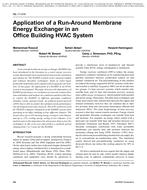Description
A run-around membrane energy exchanger (RAMEE) has been introduced in the literature as a novel energy recovery system that transfers heat and moisture between the ventilation and exhaust air. The RAMEE consists of two separate (supply and exhaust) flat-plate exchangers made of water-vapor permeable membranes and coupled with an aqueous salt solution. In this paper, the application of a RAMEE in an HVAC system is investigated. The paper discusses the dependency of RAMEE performance on ventilation air and salt solution flow rates and indoor and outdoor air conditions and describes how to control the RAMEE in different operating conditions (summer, winter, and part load). An artificial neural network (ANN) that is able to predict the optimal system performance was developed in previous research. The ANN results are used for TRNSYS computer simulation of the RAMEE system when operating in an office building in four different climates. The results show up to 43% heating energy saving in cold climates and up to 15% cooling energy saving in hot climates. Cost analysis proves the important role of pressure drop across the exchangers in life cycle cost and predicts a payback period ranging from 2 to 5 years for the RAMEE.
Citation: ASHRAE Transactions, Volume 117, Part 2, Montreal, QC
Product Details
- Published:
- 2011
- Number of Pages:
- 18
- File Size:
- 1 file , 5.4 MB
- Product Code(s):
- D-ML-11-019




